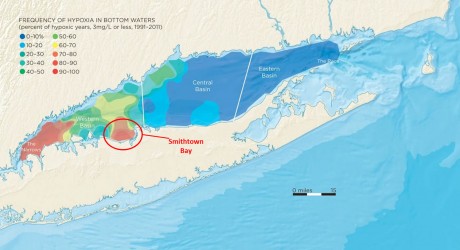Hypoxia and Smithtown Bay
Editor’s note; To get the blog going, we asked Larissa Graham, Long Island Sound Study Outreach Coordinator and an educator with New York Sea Grant, to submit the first question.
Waters that are hypoxic have low levels of oxygen, which is harmful to marine life.
Q. The map on page 5 of Sound Health shows a hypoxic area in Smithtown Bay. Do researchers know why hypoxia occurs there?
Dr. K: Dear Larissa,
Your question about Smithtown Bay (see map below) is very interesting. The primary driver of hypoxia in this case is a reduction of water circulation, which is a physical process. Let me explain further. There are numerous cases of localized hypoxia such as what is occurring in Smithtown Bay. 
Most frequently, they are caused by one or a combination of three things: 1) a nearby large source of nitrogen such as a wastewater treatment plant 2) a local source of fresh water that increases stratification, or 3) a restriction in circulation that ‘traps’ water, preventing flushing. In the case of Smithtown Bay, there is a nearby wastewater treatment facility at Kings Point, but this facility is very small, discharging only about 300,000 gallons per day (as compared to roughly 1 billion gallons per day from the six plants serving New York City), and not likely to be the primary culprit here.The tidal circulation in Smithtown Bay is greatly reduced when compared to the Sound proper (as much as 70 percent less than comparable areas in the central Long Island Sound Basin) because Cranes Neck (on the east) and Eatons Neck (on the west) block the dominant east-west tidal flow. The lack of mixing allows water in Smithtown Bay to become stratified during the summer, a process where warm fresh water floats on top of colder saltier water, and seals off the bottom water from access to oxygen from the surface. It is possible that this lack of circulation also traps nitrogen and organic matter from the wastewater treatment plant or other natural and/or human induced causes, which makes matters worse, because as that organic matter decays, oxygen is consumed.
As with many environmental problems, there is rarely a single cause nor an easy solution to hypoxia. Smithtown Bay is an excellent example of how physical factors beyond our control can contribute to, or even cause hypoxia. There are many historical accounts of hypoxia in areas with poor circulation and high stratification from before large scale human influence on our estuaries began, but there is also no doubt that increases in human induced nutrient load from sewage treatment plants and fertilizers is a major contributor to the problem. Understanding the local physics, chemistry, and biology is important to putting together the pieces of the hypoxia puzzle, and scientists are still working hard to understand the complex interplay of causes and drivers that contribute to this problem.
 Jason Krumholz, aka Dr., K, is the NOAA liaison to EPA’s Long Island Sound Office. Dr. Krumholz received his doctorate in oceanography at the University of Rhode Island Graduate School of Oceanography.
Jason Krumholz, aka Dr., K, is the NOAA liaison to EPA’s Long Island Sound Office. Dr. Krumholz received his doctorate in oceanography at the University of Rhode Island Graduate School of Oceanography.
Have a Sound Health question?
ASK DR. K!
Send an e-mail to Jason Krumholz.. Dr. Krumholz is a marine scientist working as the NOAA liaison to the EPA Long Island Sound Office. View more of Dr. K’s questions and answers on the Ask Dr. K blog.
Editor’s Note: The opinions expressed in this blog are those of the author. They do not reflect EPA or NOAA policy, endorsement, or action, and EPA or NOAA do not verify the accuracy or science of the contents of the blog.